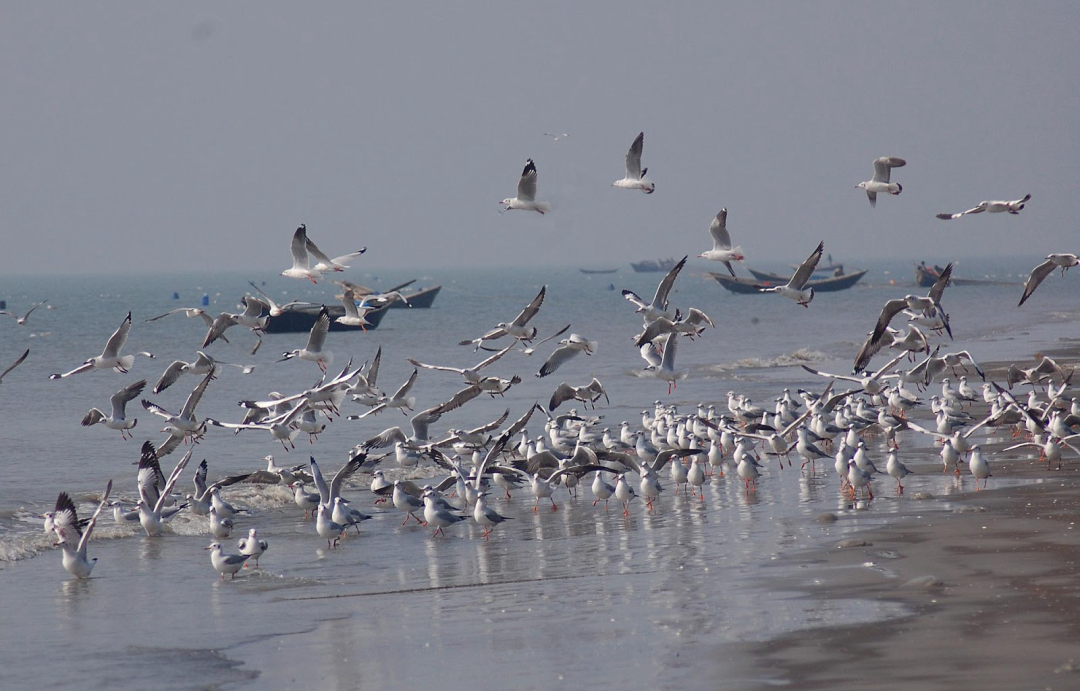Disclaimer:
Please be aware that the content herein has not been peer reviewed. It consists of personal reflections, insights, and learnings of the contributor(s). It may not be exhaustive, nor does it aim to be authoritative knowledge.
Title
Please provide a name for your action learning plan.
Biodiversity Conservation and Local Engagement: A Collaborative Approach in Kuakata
Challenge statement
Challenge type: If you are working on multiple challenges, please indicate if this is your "big bet" or "exploratory" challenge.
Please note: we ask you to only submit a maximum of 3 challenges - 1x Big Bet, 2x Exploratory. Each challenge must be submitted individually.
BIG BET
Challenge statement: What is your challenge? (Please answer in specific terms: "Our challenge is that...”.)
Our challenge is that the absence of engagement and coordination among local public-private sector stakeholders, community participation and Behavorial Insights.
Background: What is the history of your challenge? What is causing or driving it? Who is involved? How does the current situation look like? What undesired effects does it produce?
Kuakata's harmony stretches beyond the land, embracing its coastlines and oceans. It is a unique example of co-occurrence of different ecosystems. The mangroves and pristine beach areas provide critical habitat for a variety of marine creatures and provide excellent nurseries for marine fishes like Hilsha, Hamilton (Baila), Asian Sea Bass (Koral), Black Sea Bass (Bhol Koral), Silver Pomfret (Ruupchanda), dolphins and shrimps.
However, the symphony of life in Kuakata is reaching a peak of challenges.
Overfishing has strained the delicate balance of its aquatic inhabitants, disrupting the marine food chain. Unplanned tourism is causing disturbance throughout the ecosystem. Furthermore, the threat of plastic pollution is growing large, contaminating and endangering the health of its inhabitants both on land and at sea.
The local conservation teams in Kuakata lack proper training and resources to conserve biodiversity. The fishermen are unaware of the exploitation of marine resources. Moreover, the tourist's influx has large contribution in plastic pollution, so a holistic approach needs to be taken with the collaboration of all actors to maintain the sustainability between tourism and biodiversity.
In order to stop the beach and its marine habitat from deteriorating, environmental conservation is essential. The number of tourists varies seasonally, with fewer people coming during the monsoon season. It is crucial to guarantee that social progress and economic advantages are distributed fairly among nearby areas. In order to address these issues, the destination must adopt sustainable tourism practises, increase awareness, diversify its offers, and involve local stakeholders in its development and planning.
Quantitative evidence: What (official) data sources do you have on this challenge that better exemplifies the importance and urgency of this frontier challenge? You can add text, a link, or a picture.
Tourism-related activities that are unplanned and uncontrolled are causing environmental deterioration, such as beach erosion, pollution, and harm to natural habitats of Kuakata sea beach. The local infrastructure is under stress, and the area's ecological balance is being harmed by an increase in tourists and insufficient waste management practises. Statistics show that every day, at least 200 motorcycles transporting visitors travel to Kuakata, crushing at least 6,000 crabs beneath their wheels. According to a research by the Marine Journalists Network, unchecked tourism is putting Kuakata Sea Beach in danger of plastic and sound pollution. Despite the large number of visitors, there is no efficient system for managing their lodging, food, or waste, and 90% of the plastic they use is dumped on the beach every day.
link: https://www.tbsnews.net/environment/6000-crabs-die-day-kuakata-during-tourist-season-report-251887
Qualitative evidence: What weak signals have you recently spotted that characterizes its urgency? Please provide qualitative information that better exemplifies the importance and urgency of this frontier challenge. You can add text, a link, or a picture.
Kuakata Beach, a popular destination for both locals and foreign tourists, has become a dumping ground for plastic and polythene waste. A recent survey conducted by Blue-Gard, a voluntary youth organisation, in a survey in 2022 found that approximately 23kg (22.77kg) of non-biodegradable waste accumulates on the beach daily.
https://www.thedailystar.net/news/bangladesh/news/plastic-waste-plagues-kuakata-3337936
Kuakata under threat of losing tourism potential due to pollution, mismanagement
https://thefinancialexpress.com.bd/economy/bangladesh/kuakata-under-threat-of-losing-tourism-potential-due-to-pollution-mismanagement-1622203999
The embankment, planted with various species of trees and garden, eco-park and houses, are on the verge of extinction as erosion has taken a serious turn due to monsoon.
https://en.prothomalo.com/environment/Part-of-Kuakata-beach-may-disappear
Kukata - the second-largest sea beach in Bangladesh is at danger of being destroyed due to inadequate beach care. The Beach Protection Project of the Bangladesh Water Development Board (BWDB) installs geo bags and geo tubes to widen the beach and stop sand erosion. Locals claim that instead of protecting the beach, it is harming its attractiveness.
Link: https://www.jagonews24.com/amp/774252
Value proposition: What added value or unique value proposition is your Accelerator Lab bringing to solving this challenge? Why is it your Lab that needs to work on this challenge and not other actors within UNDP, other stakeholders in the country respectively? Why is it worth investing resources to this challenge?
The AccLab has robust affiliation with both governmental bodies and the private sectors who's actively engaged in the field of conservation. This unique positioning enables the lab to serve as a bridge, fostering connections between these organizations by establishing of a multi-layered coordination framework. Additionally, the conservation-centric knowledge held by UNDP at both national and global levels stands as a valuable resource that we can readily leverage within this context. In the realm of conservation, the importance of data innovation cannot be overstated. Drawing upon our wealth of experience, we are committed to empowering stakeholders with the tools and insights needed to harness the power of data for the advancement of conservation efforts.
Short “tweet” summary: We would like to tweet what you are working on, can you summarize your challenge in a maximum of 280 characters?
Connecting local stakeholders in Kuakata to bring sustainable solutions to biodiversity conservation and environmental preservation.
Partners
Who are your top 5 partners for this challenge? Please submit from MOST to LEAST important and state Name, Sector and a brief description of the (intended) collaboration.
Please state the name of the partner:
Ministry of Environment, Forestry, and Climate Change; Ministry of Fisheries and Livestock.
What sector does our partner belong to?
Government (&related)
Please provide a brief description of the collaboration.
They will support the lab with expert conservationist, research, and experimentation.
Is this a new and unusual partner for UNDP?
No
Learning questions
Learning question: What is your learning question for this challenge? What do you need to know or understand to work on your challenge statement?
1. How to create equal understanding among the different stakholders and partners of the interventions of the importance of protecting biodiversity of Kuakata island for sustainable tourism?
2. How to engage in consultations with various stakeholders, including government bodies, local government authorities, non-governmental organizations, and community representatives, in order to identify the challenges faced in Kuakata region?
3. What are the ways to strengthen partnership in collaboration with the local committees to make a long lasting sustainable environment for Kuakata's biodiversity, combating all social and environmental challanges?
4. How to reduce the existing data literacy gap through data innovation and digitalization?
To what stage(s) in the learning cycle does your learning question relate?
Sense, Explore, Test
Usage of methods: Relating to your choice above, how will you use your methods & tools for this learning question? What value do these add in answering your learning question?
These tools will be used to understand both the qualitative and quantitative context, challenges, partners demand, and inclusive solutions to the problem identified. These tools will add value to our learning questions by identifying the partners, their nature, sources of resources, making connections and analysing the current context.
Existing data gaps: Relating to your choice above, what existing gaps in data or information do these new sources of data addressing? What value do these add in answering your learning question?
Currently we don't have the exact data of the existing diversified committees prevailing at Kuakata for various purposes. We also have data gaps in identifying the number of biodiversity loss in Kuakata and the reasons behind the significant environemntal degradation. In addition tourist data from various souces provides deviation which create challenges to map effecient solutions. Thus the related data choices will accommodate us with appropriate data at the first hand.
Learning questions
Learning question: What is your learning question for this challenge? What do you need to know or understand to work on your challenge statement?
To what stage(s) in the learning cycle does your learning question relate?
Usage of methods: Relating to your choice above, how will you use your methods & tools for this learning question? What value do these add in answering your learning question?
Existing data gaps: Relating to your choice above, what existing gaps in data or information do these new sources of data addressing? What value do these add in answering your learning question?
Closing
Early leads to grow: Think about the possible grow phase for this challenge - who might benefit from your work on this challenge or who might be the champions in your country that you should inform or collaborate with early on to help you grow this challenge?
If we can connect the relevant partners and local communities of Kuakata through this leaning cycle, there are possibility of scaling and growth of this challenge by bringing sustainable solutions which are beneficial to the vulnerable community and endangered biodiversity. Through this growth phase the stakeholders including UNDP, BTB, TOAK, Local committees, community people, informal workers, hotel and restaurant owners, tourism service providers, youth community, and poorest women might be the champions in our country.
END OF ACTION LEARNING PLAN: Thank you! The form saves automatically and your submission has been recorded. You may now exit this window.


 13Climate action
13Climate action 14Life below water
14Life below water 15Life on land
15Life on land
Comments
Log in to add a comment or reply.